曲霉菌感染--- ICU患者的高危因素
ICU医院感染风险评估及感染控制措施

ICU医院感染风险评估及感染控制措施随着医疗技术的不断发展,重症监护病房(ICU)在医疗机构中的作用日益凸显,成为了救治危重患者的重要场所。
然而,ICU患者由于其特殊病情,往往需要接受多种侵袭性操作和药物治疗,这使得他们在医院感染方面面临着更高的风险。
因此,对ICU医院感染风险进行评估,并采取相应的感染控制措施,成为了保障患者安全和提高医疗质量的重要任务。
一、ICU医院感染风险评估1. 患者因素(1)基础疾病:ICU患者往往存在严重的基础疾病,如糖尿病、心血管疾病、呼吸系统疾病等,这些疾病可能导致患者的免疫力下降,增加感染风险。
(2)侵入性操作:ICU患者需要接受各种侵袭性操作,如气管插管、中心静脉置管、导尿管等,这些操作可能破坏患者的皮肤和黏膜屏障,导致病原体入侵。
(3)药物使用:ICU患者常常需要使用抗生素、激素等药物,这些药物可能导致菌群失调,增加感染风险。
2. 环境因素(1)空气质量:ICU室内空气质量不良,可能导致病原体传播。
(2)物品交叉感染:ICU内使用的医疗器械、药品等可能导致交叉感染。
(3)人员流动:ICU内人员流动频繁,可能导致病原体传播。
3. 医疗操作因素(1)无菌技术操作不规范:无菌技术操作不规范可能导致病原体入侵。
(2)抗生素使用不当:抗生素使用不当可能导致菌群失调,增加感染风险。
(3)护理措施不到位:护理措施不到位可能导致患者免疫力下降,增加感染风险。
二、ICU感染控制措施1. 加强患者因素的管理(1)提高患者免疫力:通过营养支持、适度锻炼等手段,提高患者免疫力。
(2)减少侵袭性操作:合理使用侵袭性操作,并严格遵守操作规程,减少感染风险。
(3)合理使用抗生素:根据患者病情和病原体特点,合理使用抗生素,避免菌群失调。
2. 改善环境因素(1)加强室内空气质量管理:定期通风换气,使用空气净化设备,保持室内空气质量。
(2)严格物品消毒:对ICU内使用的医疗器械、药品等进行严格消毒,防止交叉感染。
肺曲霉菌感染的诊治
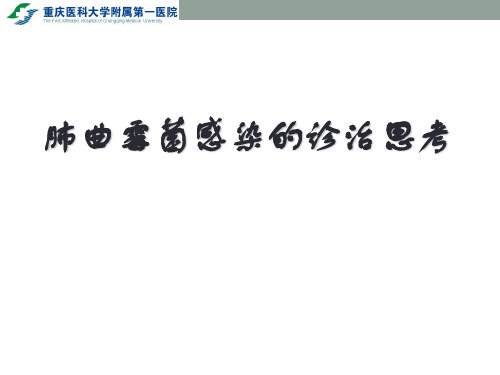
伏立康唑 氟康唑 伊曲康唑
卡泊芬净 米卡芬净
细胞内: 细胞膜重要成分麦角固醇合成路径上的14-
α-固醇去甲基酶
人体无14-α-固醇去甲基酶,抗真菌机制本身无安全 性问题
细胞膜: ß(1,3) 葡聚糖合成酶(合成细胞壁重要成分
ß(1,3) 葡聚糖)
人体无ß(1,3) 葡聚糖合成酶,抗真菌机制本身无安 全性问题
• COPD患者长期使用激素 • 高剂量全身激素>3周 • (如换算强的松龙剂量>20mg/d) • 慢性肾功能衰竭行RRT • 肝硬化/急性肝功能衰竭 • 误吸 • 糖尿病
如果无法确诊IA,下一步怎么办?
临床诊断
•宿主因素 •临床特征 •微生物的蛛丝马迹 •影像学特征
IA临床表现
感染部位 免疫状态
寻找曲霉的蛛丝马迹
非培养方法 -GM -G试验(非特异性,筛选) -PCR -IFD -MLST(多位点序列分型) -烟曲霉lgG抗体检测
21
GM试验与G试验的比较
种属 念珠菌属 镰刀菌属 隐球菌属 曲霉菌属 青霉/拟青霉属 接合菌纲
G试验
GM试验
微生物学诊断—G、GM
• 对于特定患者亚群(血液系统恶性肿瘤、HSCT),推荐使 用血清和BALF-GM,作为诊断 IA 的精确标志物(强烈推 荐;证据级别高)。
住院COPD 住院COPD 住院COPD 住院COPD
2000 2007 2013 2016
Garnacho-Montero J et al. Rev Esp Quimioter 2013;26:173 Mareș M, Moroti-Constantinescu VR, Denning DW. J Fungi (Basel). 2018 Mar 1;4(1). pii: E31. doi: 10.3390/jof4010031.
儿童真菌感染的高危因素

Chinese Journal of Practical Pediatrics Aug.2010Vol.25No.8文章编号:1005-2224(2010)08-0586-03儿童真菌感染的高危因素王丽杰,刘春峰中图分类号:R72文献标志码:B王丽杰,副主任医师、硕士研究生导师、中国医科大学附属盛京医院儿科重症监护病房副主任。
主要研究方向:儿科呼吸急救、胃肠功能障碍。
关键词:曲霉菌;念珠菌;高危因素,真菌感染Keywords :aspergillus ;candida ;predominant fac⁃tors ;fungal infection随着临床医学的发展和检验手段的日臻完善,人们对真菌感染的认识越来越深入。
侵袭性真菌感染(invasive fungal infection,IFI )是指侵袭深部组织和内脏以及全身的真菌感染,包括深部组织感染和真菌血症,致病真菌主要包括念珠菌属、曲霉菌属等条件致病真菌。
1真菌的致病性和感染途径目前深部真菌感染的发病率在许多国家都呈上升趋势,据美国全国医院感染监测系统的资料,1990年住院患者深部真菌感染率是1980年的1.9倍,居各种病原体感染率上升的首位;深部真菌感染的住院患者病死率高达29%,无真菌感染病死率为17%[1]。
杜斌等[2]对北京协和医院1953—1993年40年间共计3447例尸检病例回顾性分析,结果发现深部真菌感染85例,占2.5%,前20年发病率平均为1.5%,后20年为5.6%,明显增多。
殷菊等[3]报道北京儿童医院1983年2月至1999年10月,1000例尸检病例中发现深部真菌感染18例,占1.8%。
其中1983年2月至1996年12月深部真菌感染占1.4%(13/964);而1997年1月至1999年10月为14%(5/36)。
同期临床确诊新型隐球菌脑膜炎共21例,1997年以前13例,1997年以后5例,提示深部真菌感染近年来发病明显增多。
医院icu病房细菌感染类型有哪些
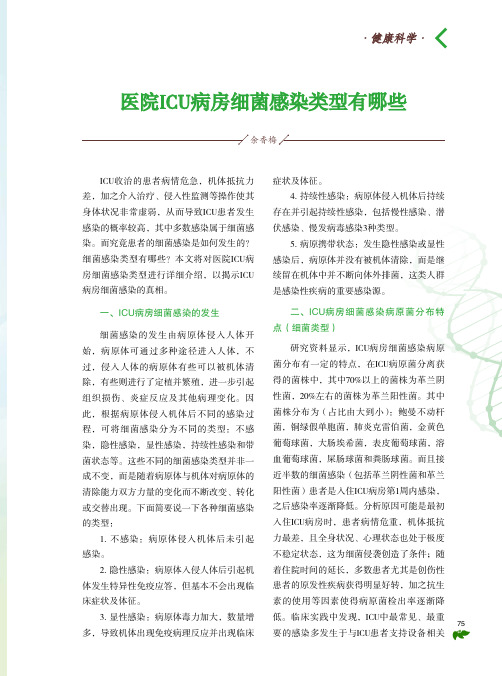
·健康科学·75成不变,而是随着病原体与机体对病原体的清除能力双方力量的变化而不断改变、转化或交替出现。
下面简要说一下各种细菌感染的类型:1. 不感染:病原体侵入机体后未引起感染。
2. 隐性感染:病原体入侵人体后引起机体发生特异性免疫应答,但基本不会出现临床症状及体征。
3. 显性感染:病原体毒力加大,数量增多,导致机体出现免疫病理反应并出现临床近半数的细菌感染(包括革兰阴性菌和革兰阳性菌)患者是入住ICU病房第1周内感染,之后感染率逐渐降低。
分析原因可能是最初入住ICU病房时,患者病情危重,机体抵抗力最差,且全身状况、心理状态也处于极度不稳定状态,这为细菌侵袭创造了条件;随着住院时间的延长,多数患者尤其是创伤性患者的原发性疾病获得明显好转,加之抗生素的使用等因素使得病原菌检出率逐渐降低。
临床实践中发现,ICU中最常见、最重要的感染多发生于与ICU患者支持设备相关76作者单位西部战区空军医院四川 成都 610021相关的血流感染、导管相关的尿路感染等。
同时,由于ICU侵入性操作频繁,且患者常伴有慢性疾病及急性生理紊乱,从而导致ICU病房多重耐药菌增多。
CIU中分离出较常见的多重耐药菌有耐甲氧西林金黄色葡萄球菌、碳青霉烯耐药铜绿假单胞菌、万古霉素耐药肠球菌、不动杆菌鲍曼不动杆菌、碳青霉烯耐药肠杆菌等。
目前,ICU抗革兰阴性菌引起的感染越来越普遍,已成为威胁世界公共卫生的重要问题。
因此,全面认识ICU病房细菌感染类型并找出感染原因、提高ICU感染管理能力尤其是控制多重耐药菌感染势在必行。
三、ICU病房患者发生细菌感染的因素患者自身因素:ICU患者自身往往携带病原菌同时也是病原菌的易感者,其呼吸、分泌物、排泄物中均含有大量的细菌,加之ICU病房护理操作频繁,医疗废物、空气污染等因素如处理不当,也易产生大量细菌,从而易引起患者细菌感染。
抗生素使用因素:ICU患者治疗过程中通常需要采用多种抗生素,这些药物的使用可引起其机体内菌群失调,同时出现耐药菌株,从而增加感染概率。
简述ICU感染常见的原因

简述ICU感染常见的原因
ICU感染指在重症监护病房内发生的感染,因为患者状态较为危急,治疗需求高,抵抗力通常较弱,容易受到病原体的侵袭。
以下是ICU感染常见的原因:
1.器械设备使用:包括呼吸机、血液透析、中心静脉导管等设备的使用,这些设备的使用可能会损伤患者的粘膜和皮肤屏障,从而导致细菌感染进入机体。
此外,这些器械设备可能存在污染,如果操作不当,也会导致感染。
2.手卫生不良:ICU病房内患者的防护意识通常普遍较弱,往往出现手卫生不良的情况,容易造成交叉感染。
医护人员在接触患者的时候也需要注意手卫生,避免污染引起感染。
3.药物治疗: 一些药物治疗可能会导致患者体内免疫力下降,使得患者的感染风险增加,例如广谱抗生素使用。
并且近些年来,抗生素快速耐药的情况大幅度加剧,使得床旁的细菌检测和有效病原细菌治疗变得越来越困难,因此药物治疗在重症监护病房内也成为引发感染的重要原因之一。
4.专科技术不足: 重症监护病房内拥有更先进的治疗设备,这些设备需要高水平的专科医生和护士进行操作,因此在某些缺乏专科人员的医院内,ICU感染的发生率相对较高。
5.基础疾病: 一些患者在入院时已经有了其他疾病,比如糖尿病,心血管疾病等,
这些患者的免疫系统已经较弱,感染的风险也相对较高。
因此,在重症监护病房内预防感染也成为了一个重要的任务,需要大家共同努力才能够最大限度地降低感染的风险。
医疗机构需要建立稳定、规范的预防措施,包括制定抗感染方案、加强医护人员的培训、鼓励对医疗器械、设备的有效使用以及提升职业素养,以提高ICU感染的预防和治疗效力。
此外,患者和家属也要依照医生的指示和规定,严格遵守限制措施,以自护和互护为主要方式,减少感染的风险。
ICU患者肺部感染的病原学特点及影响因素分析

ICU患者肺部感染的病原学特点及影响因素分析1. 引言1.1 ICU患者肺部感染病原学特点ICU患者肺部感染是一种常见且严重的并发症,其病原学特点是多样化的。
这些病原体主要包括细菌、真菌、病毒和寄生虫。
细菌是导致ICU患者肺部感染最常见的病原体,包括革兰氏阳性菌(如金黄色葡萄球菌、肺炎链球菌)和革兰氏阴性菌(如肠杆菌、铜绿假单胞菌)。
真菌感染在ICU患者中也并不罕见,主要是由念珠菌等真菌引起的。
病毒性肺部感染在ICU患者中相对较少见,但仍需引起重视。
这些病原体的特点是在ICU环境中易于传播,而且往往具有较强的致病力。
由于ICU患者的免疫功能通常较差,加之长时间的呼吸机使用和抗生素应用,使得这些病原体更容易引发肺部感染。
临床上对ICU患者肺部感染的早期诊断和治疗至关重要。
ICU患者肺部感染的病原学特点在多样性和易传播性方面表现突出,临床医生需要对不同类型的病原体有所了解,以便及时有效地进行诊断和治疗。
加强感染控制措施和提高ICU患者的免疫功能也是预防肺部感染的重要策略。
【字数:254】1.2 ICU患者肺部感染影响因素ICU患者肺部感染的影响因素包括许多方面,主要包括宿主因素、细菌因素、免疫状态、抗生素使用等。
宿主因素是影响患者易感性的重要因素之一,如年龄、性别、基础疾病、手术史等。
年龄较大、存在基础疾病、手术史等情况增加了患者罹患肺部感染的风险。
细菌因素也是导致肺部感染的重要原因,如耐药菌株、致病力较强的细菌等都会增加患者感染的难度。
免疫状态也是影响患者感染风险的重要因素,如免疫功能低下、免疫抑制剂使用等都会增加肺部感染的可能性。
抗生素使用不当也是导致ICU患者肺部感染的重要因素之一,滥用抗生素、药物耐药等情况都会增加感染的风险。
对于ICU患者肺部感染的治疗和预防,需要全面考虑这些影响因素,并制定相应的治疗方案。
2. 正文2.1 病原学特点分析ICU患者肺部感染的病原学特点分析主要包括以下几个方面:1. 常见病原体:ICU患者肺部感染的主要病原体包括细菌、真菌和病毒。
ICU院内感染的原因分析及控制措施

ICU院内感染的原因分析及控制措施院内感染是指患者发生在院内的感染。
引起院内感染的致病菌较多,且大多为多重耐药菌或泛耐药菌珠,往往感染严重,有效控制率低,病死率高。
重症监护室(ICU)是医院易感人群和易感因素的集中地,也是院内感染的高发区域。
文献报导ICU院内感染远远高出普通病房3~4倍[1]。
2010年6月~2012年12月收治ICU院内感染患者210例,进行总结分析,报告如下。
临床资料ICU住院患者680例,男450例,女230例;年龄3~97岁,平均62.3岁。
疾病包括重型颅脑损伤,高位颈髓损伤,胸部疾病,重症胰腺炎,多器官功能障碍综合征等。
发生院内感染210例,院内感染率30.88%。
其中呼吸道感染133例(63.33%),泌尿系感染50例(23.81%),颅内感染6例(2.86%),伤口感染8例(3.81%),败血症8例(3.81%),感染性休克2例(0.95%),其它感染3例(1.43%)。
病原体包括鲍曼不动杆菌、热带假单丝酵母菌、肺炎克雷白菌属、铜绿假单胞菌、葡萄球菌属、肠球菌属、大肠杆菌、白色念球菌及其他少见菌种。
ICU院内感染原因分析内在因素:①患者自身易感性:ICU内多为免疫力低下的儿童或老年患者,且病情较重,自身抵抗力较差,易受周围环境中感染因子的侵入;其次,气管插管、气管切开、深静脉置管等有创操作,破坏了患者自身的天然屏障,使ICU 院内感染的几率增加。
②易感部位:呼吸道是ICU院内感染的首要部位,其次是泌尿系感染和颅内感染及伤口感染。
外在因素:①ICU内环境因素:ICU内危重患者较多,各种监护设备及操作仪器多;医护人员及相关人员相对较多,流动性大;ICU空间相对狭小,空气污染加重,导致呼吸道感染率增加。
不合理的建筑设计及不洁净的病区环境易增加院内感染的发病机会。
②ICU内的交叉感染:ICU内患者的病情复杂,致病菌种多,且大多为生存力及繁殖力较强菌株,易在病区内交叉传播。
ICU患者常见感染部位的诊治
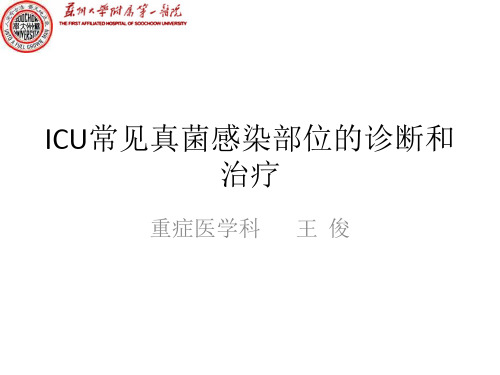
– 总感染率为51%,阳性菌株中真菌占19% – 念珠菌感染17%,仍为ICU真菌感染的主要菌属
Crit Care Med 2011 Vol. 39, No. 4
(Analyse du Management en Anesthésie et Réanimation des Candidoses invasives, 侵袭性念珠菌感染的麻醉及管理分析 )
微生物学检查
(1)血液、胸腹水等无菌体液隐球菌抗原阳性; (2)血液、胸腹水等无菌体液直接镜检或细胞学检查发现除隐球 菌外的其它真菌(镜检发现隐球菌可确诊); (3)未留置尿管情况下,连续2份尿样培养呈酵母菌阳性或尿检 见念珠菌管型; (4)直接导尿术获得的尿样培养呈酵母菌阳性(念珠菌尿>105CF U/ml); (5)更换尿管前后两次获得的两份尿样培养呈酵母菌阳性(念珠 菌尿>105 CFU/ml); (6)气道分泌物(包括经口、气管插管、BAL、PSB等手段获取的 标本)直接镜检/细胞学检查发现菌丝/孢子或真菌培养阳性; (7)经胸、腹、盆腔引流管/腹膜透析管等留取的引流液直接镜 检/细胞学检查发现菌丝/孢子或真菌培养阳性; (8)经脑室引流管留取的标本直接镜检/细胞学检查发现菌丝/孢 子或培养阳性; (9)血液标本半乳甘露聚糖抗原(GM)或β-1,3-D葡聚糖(G试 验)检测连续两次阳性
侵袭性曲霉病的流行病学、危险因素和药物敏感性的相关研究
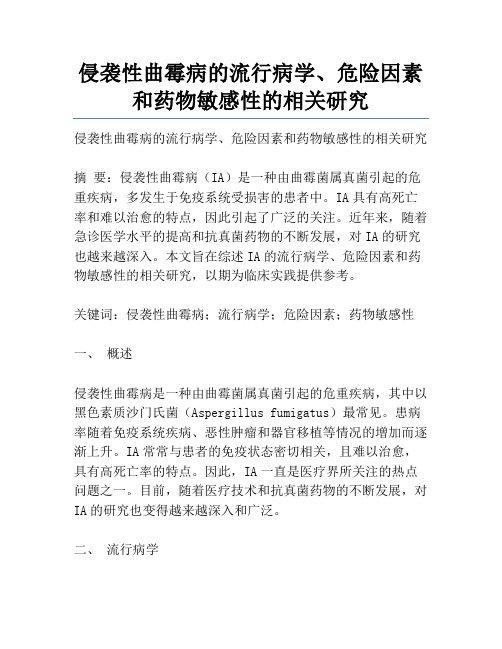
侵袭性曲霉病的流行病学、危险因素和药物敏感性的相关研究侵袭性曲霉病的流行病学、危险因素和药物敏感性的相关研究摘要:侵袭性曲霉病(IA)是一种由曲霉菌属真菌引起的危重疾病,多发生于免疫系统受损害的患者中。
IA具有高死亡率和难以治愈的特点,因此引起了广泛的关注。
近年来,随着急诊医学水平的提高和抗真菌药物的不断发展,对IA的研究也越来越深入。
本文旨在综述IA的流行病学、危险因素和药物敏感性的相关研究,以期为临床实践提供参考。
关键词:侵袭性曲霉病;流行病学;危险因素;药物敏感性一、概述侵袭性曲霉病是一种由曲霉菌属真菌引起的危重疾病,其中以黑色素质沙门氏菌(Aspergillus fumigatus)最常见。
患病率随着免疫系统疾病、恶性肿瘤和器官移植等情况的增加而逐渐上升。
IA常常与患者的免疫状态密切相关,且难以治愈,具有高死亡率的特点。
因此,IA一直是医疗界所关注的热点问题之一。
目前,随着医疗技术和抗真菌药物的不断发展,对IA的研究也变得越来越深入和广泛。
二、流行病学(一)患病率IA是一种比较罕见的真菌感染病,但却是一种重要的医院获得性感染,尤其是对于免疫系统受损害的患者。
据数据统计,全球每年发生IA的人数约为10万至20万人。
其中,欧美地区的IA发病率较高,为0.1%至0.7%,而亚洲地区的IA发病率相对较低,为0.02%至0.1%。
(二)分布情况IA主要分布在热带和亚热带地区,由于气候潮湿、温度较高等原因,曲霉菌属真菌得以在这些环境中迅速生长和繁殖。
但是,近年来随着医疗水平和条件的改善,越来越多的患者在医院内感染了IA。
据统计,约有65%至90%的IA发生于医院中,且多见于重症患者的ICU内。
(三)感染途径1. 水平传播:曲霉菌属真菌主要通过气溶胶途径传播。
患者排出的飞沫如咳嗽、打喷嚏等会释放许多含有曲霉孢子的气溶胶,在空气中漂浮数小时,易被他人吸入而引起感染。
2. 垂直传播:对于某些免疫功能受损的患者,例如新生儿、白血病患者等,也可通过感染母亲的方式传染IA。
micu免疫妥协患者

致病菌株的分布
23.8
白色念珠菌 近平滑念珠菌 热带念珠菌 光滑念珠菌 其他念珠菌
ห้องสมุดไป่ตู้
药物的敏感性
白色念珠菌
100 90 80 70 60 50 40 30 20 10 0
光滑念珠菌
100 90 80 70 60 50 40 30 20 10 0
5.J Antimicrob Chemother doi:10.1093/jac/dkt083
病原菌 凝固酶阴性球菌
发病率 (%) 35.9
死亡率 % (非ICU患者)
25.7 (13.8)
金黄色葡萄球菌
16.8
34.4 (18.9)
念珠菌属
10.1
47.1 (29)
肠球菌属.
9.8
43 (24)
铜绿假单胞菌
4.7
47.9 (27.6)
肠杆菌
4.7
32.5 (18)
克雷伯菌属
4.0
37.4 (27.3)
侵入性操作/留置导管是ICI的重要因素
•¾诊断为ICI的患者近期有侵入性操作的病史(侵入性呼吸机,导尿管和CVC)和抗生素病 史(治疗的中位值为:10天)
免疫抑制
ICI患者合并原发疾病 侵入性操作
抗生素应用
免疫抑制 免疫抑制治疗 HIV感染
中性粒细胞缺乏
留置导管 中心静脉置管 导尿管 引流管 动脉留置
念珠菌感染高危因素 ICU患者IC危险因素7,8
曲霉菌感染高危因素10 高危因素
入住ICU时间延长(患者的感染风险在入住 7-10天后快速增加)
其他患者IC危险因素7,9
念珠菌定植 中性粒细胞缺乏 应用激素及免疫抑制剂 肿瘤化疗 应用广谱抗生素 出血或肾功能衰竭 应用中心静脉置管 疾病的严重程度(APACH II 评分)
ICU常见感染的预防与护理
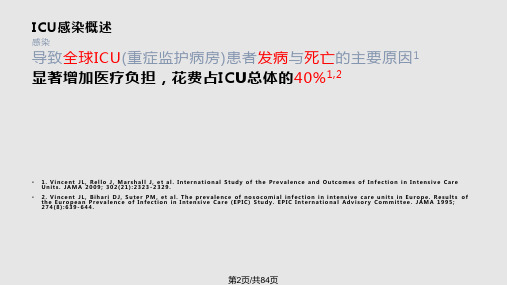
➢气道温度:320C-370C ➢气道湿度:100% ➢湿化量:>250ml/天
第23页/共84页
第24页/共84页
VAP的预防与护理
气道的湿化 热湿交换器(HME)
• 又称“人工鼻”,原理是将呼出气中的热和水气收集和利用以温热和湿化吸入的气体 • 主要用于人工气道的患者,特别是持久气管造口患者在自主呼吸时可应用HME
手卫生
第10页/共84页
医院内肺炎预防与控制标准操作规程
呼吸机螺纹管和湿化器应每周更换1-2次,有明显分泌物污染 时应及时更换;螺纹管冷凝水应及时倾倒,不可使冷凝水流向 患者气道;湿化器添加水应使用无菌用水,每天更换
每日停用镇静剂,评估是否撤机和拨管,减少插管天数 应对医务人员包括护工定期进行有关预防措施的教育培训
第30页/共84页
第31页/共84页
CRBSI的预防与护理
• 输液港(implantable venous sccess port) 完全植入人体内的闭合输液装置,包括尖端位于上腔静脉的导管部分及埋植于皮下的注射座。 • 外周静脉导管(peripheral venous catheter PVC)
病原体:革兰阳性菌最主要 表葡:皮肤污染,占CRBSI 30% 金葡:最常见,占院内血行感染13.4% 耐万古肠球菌(VRE) 铜绿、嗜麦芽、鲍曼、阴沟杆菌 真菌:白念,血行感染的5.8%,曲霉菌
第36页/共84页
导管相关血行感染的诊断标准
确诊:具备下述任一项,可证明导管为感染来 源
1、有1次半定量导管培养阳性(每导管节段 ≥15CFU)或定量导管培养阳性(每导管节段 ≥1000CFU),同时外周静脉血也培养阳性并 与导管节段为同一微生物。
重症患者侵袭性真菌感染诊断和治疗指南解读

真菌感染的特点: 两高、两低、一快、一毒
念珠菌直接镜检
假菌丝和芽孢
ICU患者IFI的流行病学情况
ICU患者IFI的发病率不断增加,约占医院获得性 感染的8~15% ICU患者IFI的病原菌主要包括念珠菌和曲霉
ICU患者IFI仍以念珠菌为主
白色念珠菌是ICU患者IFI最常见的病原菌(约占 40%~60%) ICU患者侵袭性曲霉感染的发生率在逐年上升, 并越来越受到重视
热带念珠菌 35%
假丝酵母菌 12% 曲霉菌 6%
痰 53%
白念 47%
非恶性肿瘤患者中侵袭性曲霉 菌病的发生率
ICU收治1850例病例中 127例确诊/临床诊断曲霉菌病
7%
Meersseman et al. Am J Resp Crit Care Med 2004;170:621-5
SOT受者IFI的类型分布及病 原体的分布
重症患者IFI的诊 治流程
宿主因素
确诊IFI 临床特征 临床诊断IFI 微生物学检查 拟诊IFI 组织病理学 IFI 防治策略
1.一般预防 2.靶向预防 3.经验性治疗 4.抢先治疗 5.目标性治疗
抗真菌治疗原则
由于真菌感染的复杂性,目前多提倡分层治疗,包括 预防性治疗、经验性治疗、抢先治疗及目标性治疗。
ICU患者侵袭性真菌感染的 高危因素
immunocompromised
ICU患者的免疫状态
immunoparalysis
immunocompetent
ICU患者与其它科室的患者相比,最突出的特点
是其解剖生理屏障完整性的破坏。 ICU患者往往带有多种插管,且消化道难以正常 利用,较其他病人具有更多生理屏障损害,因此使得 正常定植于的条件致病真菌,以及环境中的真菌易于 侵入原本无菌的深部组织和血液。
ICU院内感染的原因及对策

ICU院内感染的原因及对策院内感染一般都发生于医院内部,医院感染的致病菌多种多样,而且大部分都是一些耐药菌株,因而一般出现医院感染,都比较严重。
本文首先分析了ICU院内感染的原因,进一步得出了ICU院内感染的对策。
1.ICU院内感染的原因1.1医院环境影响ICU中的患者的病情均比较危及,患者自身的抵抗力差,属于最易被感染的人群。
加之病原菌、易感人群比较集中,空气中的自然菌、人工感染菌的密度也会增加。
如果在此种情况下,医院的空气消毒工作不到位,就会出现空气污染,从而使患者术后出现伤口感染,这是导致医院感染的一个诱发因素。
另外,如果对探视者的消毒工作没做好,他们也会有携带病原菌的可能。
一旦室内的空气中细菌的密度超标,细菌就会分布在ICU室内的物体上,就会增加细菌的传播。
另外,治疗过程中的一些操作,如输液、穿刺、皮肤护理等环节,会产生一定的医疗废弃物,处置过程中也会出现一定的空气污染。
1.2应用抗生素在对ICU 患者的治疗中,难免会用到抗生素。
抗生素的确有它独特的作用,尤其体现在其控制人体内菌群比例的作用上。
但抗生素的使用,会增加耐药菌株,患者的病程就会相应地被拉长,从而使感染的机率也随之增加。
在ICU中使用的抗生素,通常都具有很强的杀伤力,而且多数患者在进入重症监护室之前,都已经使用过抗生素药物。
在此情况下,在重症监护室产生的耐药菌株,将流行到院内,就很难对其进行有效地控制。
再加上重症监护室中的患者,又属于易感人群,这就更加加大了感染控制的难度。
1.3侵入操作较多当前医院中的侵入性操作逐渐增加,大量的有创伤口,会使患者更容易发生医院感染。
比如像气管切开、吸入装置、动静脉导管、监测仪探头等,都属于侵入性治疗的方法。
而这些侵入性操作,仪器设备上会附着一定的微生物,这些微生物会顺着仪器进入到体内,从而会使机体的防御屏障受到一定的损坏,造成更多的有创伤口。
基于此,病原体就会很容易入侵机体。
除此之外,静脉采血等操作中,如果出现护理不当的情况,也会有可能出现侵入性感染。
重症监护室(icu)常见感染原因分析及预防措施

重症监护室(icu)常见感染原因分析及预防措施前言:近些年,在重症监护室中患者的院内感染的问题越发被获得关注,其为导致患者死亡,诱发器官功能衰竭的重要原因,因患者所处的环境较为封闭,以及多种管路如导尿管和血管内导管、气管插管等的运用,导致机体在外部病原体中暴露,同时也受到免疫功能有所下降的影响,所以更会加大重症监护室感染问题的出现率,这也为当前重症监护室中所面对的一项严重问题。
基于此,本文就以重症监护室(icu)常见感染原因分析为出发点,而后探讨了重症监护室(icu)常见感染预防措施。
一、重症监护室(icu)常见感染原因分析在重症监护室的感染中,下呼吸道感染最为常见,在医院重症监护室中的患者,其病情通常十分严重,受到侵袭性操作等许多因素的影响,会提高患者出现下呼吸道感染情况的概率,并且该种感染状况一般会出现在应用人工呼吸机、以及进行气管插管的一些患者身上,同时一些患者的意识还并不清楚,气道廓清功能障碍,难以清理好呼吸道,所以在其咽喉部中所存在的细菌,就易于通过气管插管入侵至患者的气管中,导致发生严重的下呼吸道感染状况。
在重症监护室中的患者,也容易发生泌尿道感染状况,这不但和患者免疫力降低之间有关,也和导尿之间存在关联,而若是长久留置导尿管,会加大感染的发生率,再者,若是在进行导尿操作时,并非标准与合理,也未能严格落实无菌操作,就更易于引发严重的泌尿道感染。
重症监护室医护人员在治疗或是护理患者前,如没能根据规定及时洗手,或是未能标准着装,针对患者的尿液和唾液等,未能展开有效的处理,也容易导致发生严重的感染问题。
在利用器材进行操作前,如没能实施有效的器材消毒,在展开实际操作时也会加大感染问题发生的概率。
除此之外,针对血管内导管的感染,中心静脉置管以及插管位置潮湿等,也易导致感染状况出现。
二、重症监护室(icu)常见感染预防措施(一)强化对呼吸道的管理在重症监护室中的患者,其状况往往十分危重,必须确保其呼吸道的通畅性,避免引流物或是分泌物掉入到气管中,致使发生感染状况。
医院感染的高危因素(1)
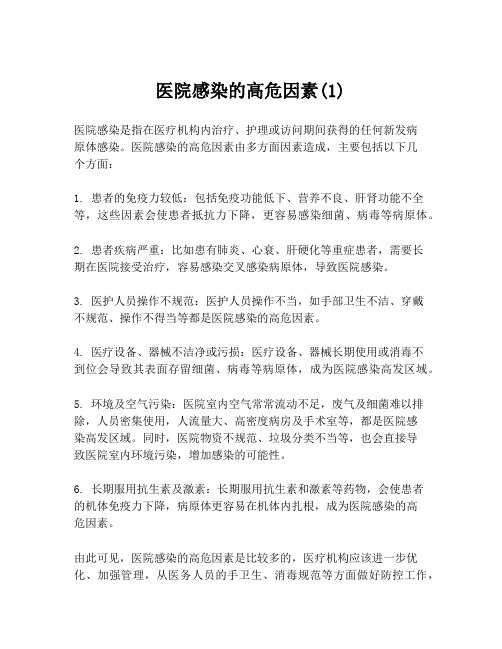
医院感染的高危因素(1)
医院感染是指在医疗机构内治疗、护理或访问期间获得的任何新发病
原体感染。
医院感染的高危因素由多方面因素造成,主要包括以下几
个方面:
1. 患者的免疫力较低:包括免疫功能低下、营养不良、肝肾功能不全等,这些因素会使患者抵抗力下降,更容易感染细菌、病毒等病原体。
2. 患者疾病严重:比如患有肺炎、心衰、肝硬化等重症患者,需要长
期在医院接受治疗,容易感染交叉感染病原体,导致医院感染。
3. 医护人员操作不规范:医护人员操作不当,如手部卫生不洁、穿戴
不规范、操作不得当等都是医院感染的高危因素。
4. 医疗设备、器械不洁净或污损:医疗设备、器械长期使用或消毒不
到位会导致其表面存留细菌、病毒等病原体,成为医院感染高发区域。
5. 环境及空气污染:医院室内空气常常流动不足,废气及细菌难以排除,人员密集使用,人流量大、高密度病房及手术室等,都是医院感
染高发区域。
同时,医院物资不规范、垃圾分类不当等,也会直接导
致医院室内环境污染,增加感染的可能性。
6. 长期服用抗生素及激素:长期服用抗生素和激素等药物,会使患者
的机体免疫力下降,病原体更容易在机体内扎根,成为医院感染的高
危因素。
由此可见,医院感染的高危因素是比较多的,医疗机构应该进一步优化、加强管理,从医务人员的手卫生、消毒规范等方面做好防控工作,
加强医患宣传,减少感染的风险和安全隐患,切实保障广大群众的健康和安全。
ICU真菌感染特点及治疗策略

非药物治疗
支持治疗包括维持水电解质平衡、控制体温、 保持呼吸道通畅等,有助于改善患者的免疫功
能和减轻感染症状。
营养支持包括提供足够的热量、蛋白质、维生素和矿 物质等,有助于改善患者的营养状况和提高抵抗力。
icu真菌感染特点及治疗策 略
• 引言 • icu真菌感染概述 • icu真菌感染的发病机制 • icu真菌感染的治疗策略 • 案例分析 • 结论
01
引言
背景介绍
01
重症监护病房(ICU)患者由于免疫功能低下、接受广谱抗生素 和侵入性操作等原因,容易发生真菌感染。
02
真菌感染在ICU中具有较高的发病率和死亡率,对患者的生命安
诊断
通过血培养和骨髓穿刺 检查,确诊为血液念珠 菌感染。
治疗
采用氟康唑和卡泊芬净 进行治疗,同时进行抗 真菌支持治疗。
结果
经过治疗,患者症状得 到缓解,病情逐渐好转, 最终康复出院。
06
结论
研究成果总结
01
02
03
总结了ICU真菌感染的常 见病原体、感染途径、 易感因素和临床特征。
分析了当前治疗ICU真菌 感染的常用药物及其疗
03
icu真菌感染的发病机制
发病机制
免疫系统受损
ICU患者通常存在免疫系统受损, 导致身体对真菌的抵抗力降低。
长期使用抗生素
抗生素的长期使用会破坏肠道菌群 平衡,使真菌容易繁殖并进入血液。
医疗设备污染
医疗设备如呼吸机、导管等在使用 过程中可能成为真菌传播的途径。
易感因素
01
ICU医院感染管理知识试题及答案
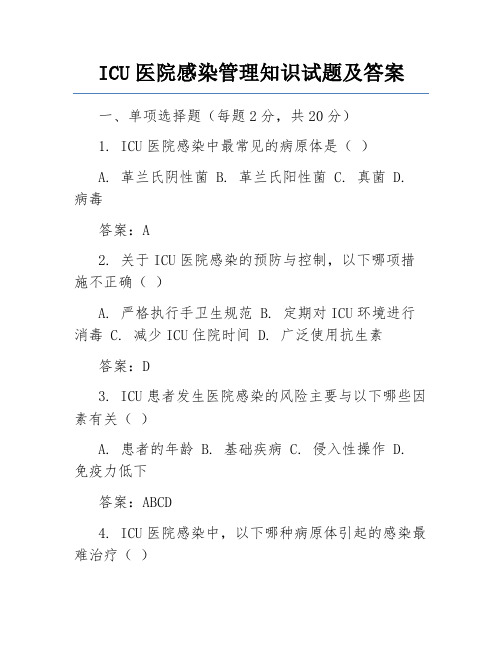
ICU医院感染管理知识试题及答案一、单项选择题(每题2分,共20分)1. ICU医院感染中最常见的病原体是()A. 革兰氏阴性菌B. 革兰氏阳性菌C. 真菌D. 病毒答案:A2. 关于ICU医院感染的预防与控制,以下哪项措施不正确()A. 严格执行手卫生规范B. 定期对ICU环境进行消毒C. 减少ICU住院时间D. 广泛使用抗生素答案:D3. ICU患者发生医院感染的风险主要与以下哪些因素有关()A. 患者的年龄B. 基础疾病C. 侵入性操作D. 免疫力低下答案:ABCD4. ICU医院感染中,以下哪种病原体引起的感染最难治疗()A. 革兰氏阴性菌B. 革兰氏阳性菌C. 真菌D. 病毒答案:C5. ICU医院感染监测的主要目的是()A. 及时发现和控制感染B. 评估治疗效果C. 了解感染病原体分布D. 制定感染预防策略答案:A6. 关于ICU医院感染的诊断,以下哪项条件不具备即可诊断为医院感染()A. 感染发生在ICU住院期间B. 感染病原体与ICU 环境相同C. 感染发生在ICU住院后48小时内D. 感染发生在ICU住院后7天内答案:A7. ICU医院感染中,以下哪种病原体引起的感染最容易导致多重耐药()A. 革兰氏阴性菌B. 革兰氏阳性菌C. 真菌D. 病毒答案:A8. 在ICU中,以下哪种操作最容易导致医院感染()A. 插管B. 手术C. 输血D. 给药答案:A9. ICU医院感染的预防与控制中,以下哪种措施最为重要()A. 手卫生B. 消毒隔离C. 合理使用抗生素D. 提高患者免疫力答案:A10. ICU医院感染中,以下哪种病原体引起的感染最容易通过空气传播()A. 革兰氏阴性菌B. 革兰氏阳性菌C. 真菌D. 病毒答案:D二、多项选择题(每题3分,共30分)1. ICU医院感染的预防与控制措施包括()A. 严格执行手卫生规范B. 定期对ICU环境进行消毒C. 减少ICU住院时间D. 广泛使用抗生素E. 提高患者免疫力答案:ABCE2. ICU医院感染中,以下哪些因素会增加患者感染的风险()A. 患者的年龄B. 基础疾病C. 侵入性操作D. 免疫力低下E. 长时间使用抗生素答案:ABCDE3. ICU医院感染的监测方法包括()A. 临床症状观察B. 实验室检测C. 影像学检查D. 病原体分离培养E. 流行病学调查答案:ABCDE4. ICU医院感染的诊断标准包括()A. 感染发生在ICU住院期间B. 感染病原体与ICU 环境相同C. 感染发生在ICU住院后48小时内D. 感染发生在ICU住院后7天内E. 感染病原体为多重耐药菌答案:ACDE5. ICU医院感染中,以下哪些病原体可以引起肺部感染()A. 革兰氏阴性菌B. 革兰氏阳性菌C. 真菌D.病毒 E. 寄生虫答案:ABCDE三、简答题(每题10分,共30分)1. 请简述ICU医院感染的预防与控制措施。
ICU患者侵袭性真菌感染

念珠菌属的分布和与之相关的粗死亡率
粗 死 亡 率
Hilmar Wisplinghoff, et al.Clinical Infectious Diseases 2004; 39:309–17
%
白色念珠菌
光滑念珠菌
近平滑念珠菌
热带念珠菌
克柔念珠菌
所有念珠菌
念珠菌属( 占分离菌的百分比 )
近年来,非白色念珠菌的分离率有所上升
ICU中发生侵袭性念珠菌病的危险因素
住院时间长 高敏感性 糖尿病 肾衰竭 血液透析 急性胰腺炎 广谱抗生素的使用 中心静脉导管 癌症和化疗 肠外营养 外科手术 移植 服用免疫抑制剂 多处念珠菌定植
Luis Ostrosky-ZeichnerCrit Care Med 2006; 34:857–863
全国基层医疗机构 抗菌药物合理应用
培训项目
ICU患者侵袭性真菌感染
于凯江
哈尔滨医科大学附属第二医院
一、概述
在过去的几十年中ICU患者IFI的发病率不断增加, 约占医院获得性感染的8பைடு நூலகம்15%
其病原菌主要包括念珠菌和曲霉,念珠菌中白念 珠菌是最常见的病原菌,但近年来非白念珠菌(如 光滑念珠菌、热带念珠菌、近平滑念珠菌等)感染 的比例在逐渐增加
TRANSNET
• 移植相关感染监控网络(Tranplant Associated Infection Survillance Network, TRANSNET) • CDC发起,美国阿拉巴马州立大学作为协作中心, 包括全美25家移植中心 • 起始时间2001年3月
• 统计的实体脏器移植受者数目为16184例(54%), HSCT受者数目为13933例(46%)
- 1、下载文档前请自行甄别文档内容的完整性,平台不提供额外的编辑、内容补充、找答案等附加服务。
- 2、"仅部分预览"的文档,不可在线预览部分如存在完整性等问题,可反馈申请退款(可完整预览的文档不适用该条件!)。
- 3、如文档侵犯您的权益,请联系客服反馈,我们会尽快为您处理(人工客服工作时间:9:00-18:30)。
曲霉菌病感染--- ICU患者的高危因素
侵袭性曲霉菌病(Invasive Aspergillosis , IA)是曲霉菌感染人体致病最严重的一种形式。
对于ICU的危重患者,有报道的IA的发病率高达10%,1这个数字要高于以往其他疾病人群所报道的数字0.33-6.9%。
2事实上,在ICU患者中,IA的危险因素有很多,不仅仅限于由EORTC/MSG指南中提到的单一的宿主因素。
比如,长期糖皮质激素治疗的患者,慢性阻塞性肺病(Chronic Obstructive Pulmonary Disease, COPD),肝硬化,实体器官肿瘤,HIV感染,肺移植,以及较长时间的ICU住院(大于21天)等。
3两项针对COPD患者伴发IA研究分析发现,这类患者的临床结局都非常差,死亡率均达到了100%。
4,5在2014年另一项研究中,COPD伴发IA的死亡率为66%。
1 在欧洲癌症研究和治疗组织和真菌病研究组(European Organization for Research and Treatment Cancer and Mycoses Study Group, EORTC/MSG)的标准中,类固醇使用超过三周以上被认为是IA的危险因素。
对于严重的和/或持续的败血性休克患者,使用低剂量的类固醇(盐皮质激素)可以改善临床结局。
6但它们也对巨噬细胞杀伤曲霉菌孢子和单核细胞杀伤曲霉菌菌丝的作用存在损害。
7 对于有肺部疾病的患者,即使使用低剂量的类固醇,其伴发IA的风险也会更高。
8对于肝硬化患者,由于其细胞吞噬作用和趋化作用受损,被认为是导致IA发病的可能因素。
9
由于ICU患者伴发IA有较高的发病率和死亡率,建立可以实现早期诊断的检测方法或诊断标准就非常有意义。
血清曲霉菌抗或半乳甘露聚糖(galactomannan, GM)是有报道的血液肿瘤患者中IA检测的可靠手段。
10 GM检测比较于其他方法,可以帮助临床提早8天诊断IA。
11血清GM抗原是曲霉菌细胞壁的多糖成分,在曲霉菌菌丝侵袭机体组织时释放。
这个成分可通过一步夹心酶联免疫法进行检测。
近年的一些研究证实,在血液肿瘤患者中,由于GM水平升高与较差的临床结局呈强相关,因此认为GM抗原检测也可作为IA临床结局的衡量工具。
12,13
GM抗原检测所使用的试剂为Bio-Rad公司的曲霉菌抗原检测试剂盒(Platelia TM Aspergillus Ag),该试剂为一步夹心酶联免疫法,利用单克隆抗体(EBA-2)对血液循环中的GM抗原。
推荐首次检测时间点一般为当临床怀疑患者发生IA时,或者需要对免疫妥协患者进行常规筛查时。
1 另外,对于开始进行抗真菌治疗的患者,推荐进行每周两次的GM水平监测,以帮助判断临床疗效及患者预后。
14
1. Suzanne Teering, Annelies Verreth, Anneleen Peeter, et al Prognostic value of serum galactomannan in mixed ICU patients: a
retrospective observational study Anaesthesiology Intensive Therapy 2014, vol. 46, no 3, 145–154
2. Meersseman W, Vandecasteele SJ, Wilmer A et al.: Invasive aspergillosis in critically ill patients without malignancy. Am J Respir Crit Care Med 2004; 170: 621–625.
3. Dimopoulos G, Frantzeskaki F, Poulakou G et al.: Invasive aspergillosis in the intensive care unit. Ann NY Acad Sci 2012; 1272: 31–39.
4. Bulpa PA, Dive AM, Garrino MG et al.: Chronic obstructive pulmonary disease patients with invasive pulmonary aspergillosis: benefits of intensive care? Intensive Care Med 2001; 27: 59–67.
5. Rello J, Esandi ME, Mariscal D et al.: Invasive pulmonary aspergillosis in patients with chronic obstructive pulmonary disease: report of eight cases and review. Clin Infect Dis 1998; 26: 1473–1475.
6. Annane D, Sébille V, Charpentier C et al.: Effect of treatment with low doses of hydrocortisone and fludrocortisone on mortality in patients with septic shock. JAMA 2002; 288: 862–871.
7. Lionakis MS, Kontoyiannis DP: Glucocorticoids and invasive fungal infections. Lancet 2003; 362: 1828–1838.
8. Palmer LB, Greenberg HE, Schiff MJ: Corticosteroid treatment as a risk factor for invasive aspergillosis in patients with lung disease. Thorax 1991; 46: 15–20.
9. Bailey RJ, Woolf IL, Cullens H et al.: Metabolic inhibition of polymorphonuclear leucocytes in fulminant hepatic failure. Lancet 1976; 1: 1162–1163.
10 .Maertens J, Verhaegen J, Lagrou K et al.: Screening for circulating galactomannan as a noninvasive diagnostic tool for invasive aspergillosis in prolonged neutropenic patients and stem cell transplantation recipients: a prospective validation. Blood 2001; 97: 1604–1610.
11. Maertens J, Van Eldere J, Verhaegen J et al.: Use of circulating galacto-mannan screening for early diagnosis of invasive aspergillosis in allogeneic stem cell transplant recipients. J Infect Dis 2002; 186: 1297–1306.
12. Woods G, Miceli MH, Grazziutti ML et al.: Serum Aspergillus galactomannan antigen values strongly correlate with outcome of invasive aspergillosis: a study of 56 patients with haematologic cancer. Cancer 2007; 110: 830–834.
13. Koo S, Bryar JM, Baden LR et al.: Prognostic features of galactomannan antigenemia in galactomannan-positive invasive aspergillosis. J Clin Microbiol 2010; 48: 1255–1260.
14. Lehrnbecher T, Phillips R, Alexander S, et al. Guideline for the Management of Fever and Neutropenia in Children With Cancer and/or Undergoing Hematopoietic Stem-Cell Transplantation. Journal of Clinical Oncology. 2012 epub ahead of print. This manuscript is the first pediatric fever and neutropenia guideline. It summarizes the impact of both galactomannan and beta glucan testing in children.。
